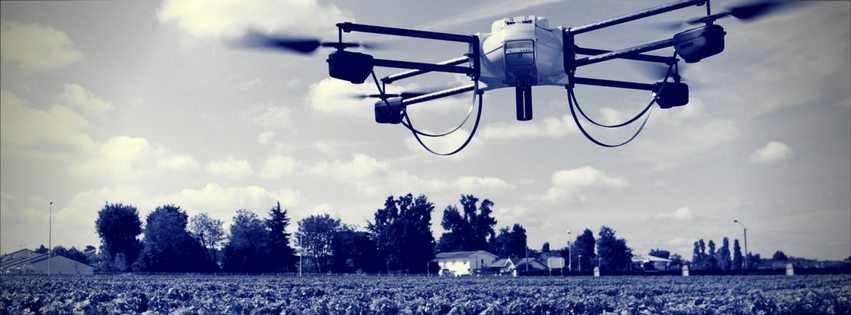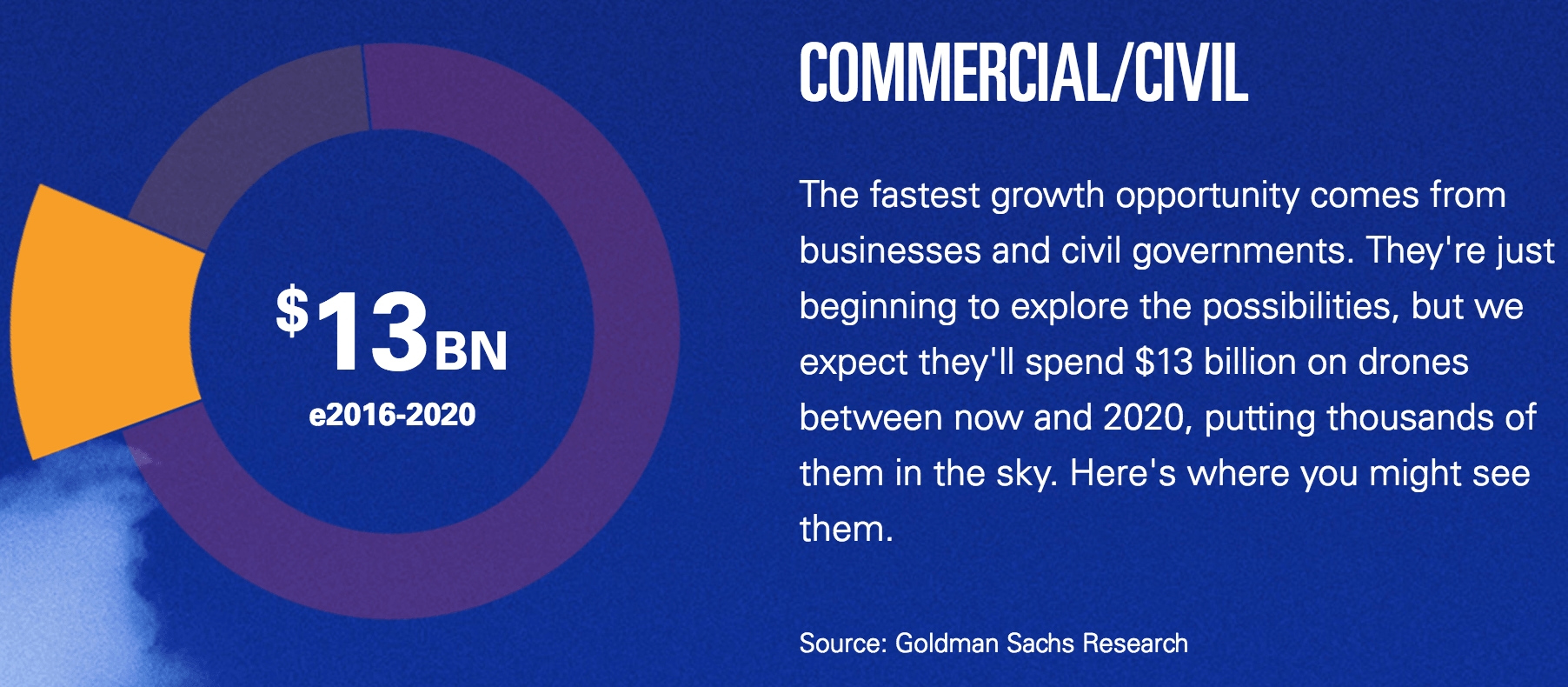
High costs and technical limitations kept the uses of drones relatively limited until recently. After significant excitement starting around 2012, the FAA’s 2016 adoption of regulations – combined with the drop in price – has made drones an economically viable option for a broad range of commercial functions.
But what do these changes mean for businesses and governments who are eager to implement drone applications? In this article, we’ll explore topics that business leaders should be asking, including:
- What are the current businesses uses of drones that have a strong ROI today?
- What are real Fortune 500 businesses doing to implement drones in their processes today?
- What are some of the factors limiting drone delivery and other commercial uses?
We’ll begin with an outline of the state of drones on business today, followed by a series of deep-dives into individual drone use cases.
A Rapid Growth in Industrial Drone Applications
In late 2016, our consensus of 30 AI researchers yielded “drones and robotics” around the top of the list of near-term business applications of AI, but our experts weren’t the only ones who tuned into the trend.
Gartner estimates that over 170,000 commercial drones will be sold this year, a 58 percent increase since 2016. Goldman Sachs predicts that businesses and civil government will spend $13 billion on drones between 2016-2020.

Cheap, ubiquitous drones have the potential to significantly increase efficiency in several areas. PwC projects that globally, drone solutions have the high potential to replace $127 billion in current business services and labor costs across multiple industries. They assume drones could have the biggest impact on infrastructure, agriculture, and transportation.
Of all drone applications explored so far, delivery robots have generated by far the most public attention, but the use of delivery drones is still mainly in early phases. Federal and local regulations are holding back their potential use. Commercial drones are currently making a real impact in applications that take advantage of their ability to quickly and cheaply gather localized visual information. Several such areas are agriculture, construction, infrastructure, and inventory management. Industries that already benefiting from a cheap eye in the sky.
Agricultural Uses of Drones
Drones a natural fit with the world of agriculture, where farmers can benefit from real time information about large tracts of land. Drones can help track almost everything including water use, crop health, heat signatures, and soil analysis. Expensive aerial surveillances that could previously only be done occasionally with planes can now be completed weekly or even daily with drones that cost only hundreds of dollars.
Back in 2015 the American Farm Bureau Federation released a study that found for farmers using drones as a service, the average ROI is “$12 per acre for corn, $2.60 per acre for soybeans, and $2.30 per acre for wheat.” Thanks to the strong ROI, many predict the use of drones for farming will continue to grow. WinterGreen Research put the current agricultural drone market at $494 million and expects it will increase to $3.69 billion by 2022.
Several new start-ups and existing agriculture players are investing heavily in agriculture drones and the software needed to analyze the raw data. For example, John Deere has partnered with Sentera to provide its consumers access to their AgVault™ Software and agriculture scouting drones. In just one season, Sentra equipment performed 8,000 flights gathering 175 terabytes of data. Drones are allowing farmers to gather so much data about their fields that managing all this data has created an important business opportunity.
Similarly, Dupont’s agribusiness division, Dupont Pioneer, has invested in PrecisionHawk to help “farmers to increase profitability and sustainability through data-driven insights.” PrecisionHawk offers a fully integrated product for all tiers of businesses. It can provide the drones, the sensors, the software, the analysis, the pilot, the insurance, and the regulatory filings.
Agriculture continues to be one of the most exciting (and in our opinion, least covered) industrial application of robotics and drones. Though we’ve covered some applications in our recent article on AI for location data, we’re likely to include more agricultural use-cases in our research section soon.
Infrastructure Development and Maintenance with Drones
The use of drones to inspect existing infrastructure can be cheaper, faster, and importantly safer. For example, the New York Power Authority recently tested using drones to inspect an ice boom near Lake Erie. Inspecting one of these ice booms normally costs $3,500 to send a helicopter or $3,300 to send a boat to perform the task, but it cost less than $300 to deploy a drone.
That is why several utility companies were quick to move once given the OK by the FAA last year. AT&T is using drones to inspect cell towers, a move that could save lives. From 2013-2016 there were 34 communication tower-related fatalities.
Several energy companies like Southern Company, and Duke Energy are using drones to inspect power lines, power plants, and storm damage. SunPower is using drones to improve solar farms. Similarly, start-ups such as SkySpecs are using drones to perform inspections of wind turbines which used to take hours in just minutes.
Bridges, dams, oil platforms, wind turbines solar farms, communication towers, and basically any other hard to infrastructure is seeing companies experiment with drones for inspections.
It’s reasonable to suppose that as drones and robots become more dexterous and autonomous, more of today’s robotics vendor companies will find profitable applications in infrastructure maintenance. This trend will likely extend to underwater robots, gliders, and more.
Drones as Infrastructure
Drones aren’t just being used to inspect traditional infrastructure but also to replace it. In early 2017 AT&T successfully tested their comically named Flying COW (Cell on Wings). The drone functions as a small replacement cell tower which can be deployed at disaster scenes or during big events to spread the load placed on static towers.
Facebook is looking to use drones not just as a temporary replacement for current infrastructure but as a permanent replacement. Facebook is working on building Aquila, a massive solar-powered drone that would stay in the air for months beaming internet to remote or impoverished areas. The technology is still in the development phase but the goal is to bring internet to the “more of the 4 billion people who are not online” and therefore not using Facebook. The technical challenges though are significant. Google recently shutdown their own very similar drone internet project and move employees to their plan to expand internet access via high altitude balloons.
Construction Drone Applications
Real time aerial inspection allows for the ability to quickly survey sites or catch mistakes. According to PwC, threatening accidents on construction sites monitored by drones decreased by up to 91 percent.
Autodesk, an industry leader in software for architecture and construction, has made multiple investments in drone maker 3D Robotics via its Forge Funds since 2016. 3D Robotics is using Autodesk’s Forge Platform to provide a UAV-to-cloud solution. Their drones can capture site data that is fed into Autodesk software for analysis.
This year Caterpillar, one of the largest construction equipment manufacturers, invested in drone startup Airware. Their services will be offered via Caterpillar’s existing dealer network. The company’s drones can be used for inspecting roofs, construction sites, mining operations, and utilities.
Warehousing and Inventory Drone Applications
Using drones to quickly scans thousand of crops in a field is not much different than using drones to scan thousands of items in a warehouse, so it is only natural that large retailers are adopting similar drone technology for their inventory needs. Wal-Mart has been testing the use of drones in its warehouses to check and flag missing items. According to the company, drones flying through the warehouse can do a full inventory check in a day, a task that currently takes a month for people to do manually.
While it appears that Wal-Mart may be developing their own drones for inventory applications, there are plenty of drone vendors intent on entering the space. Below is a video from Eyesee, an AI drone vendor:
Astute readers should take note that AI applications developed by retail business leaders (like Amazon, Wal-Mart, Target, others) will quickly be replicated by vendor companies and startups. If Amazon’s recommendation systems drive significant additional profit (and they do), then startups and vendor companies will find a way to offer recommendation systems to other companies (and they are). If Wal-Mart’s inventory drones save the company a tremendous amount of money, business leaders should expect to be able to buy this technology from an innovative vendor sooner or later.
Conclusion

Major companies like Amazon and Facebook are investing significantly in the use of drones for delivery and expanding internet access, but for the most part these applications are in the testing phase. We recently covered Domino’s drone delivery plans, which are also very much in research and development for the time being. There are companies like Zipline, which is currently using aerial drones to make medical deliveries in Rwanda, but that represents a minor application compared to what some companies envision.
Where commercial drones are currently making the biggest impact by cheaply and quickly serving as a company’s eyes and ears. Drones are seeing real use in industries that need to gather large amounts of visual data or access hard to reach places. Where we are seeing them already in real use is businesses such as:
- Agriculture
- Forestry
- Surveying
- Infrastructure inspection
- Utilities
- Construction
- Mining
- Entertainment
- Insurance claim inspection for buildings or larger facilities (auto accidents can most likely be assessed with a simple camera on-site, used by an insurance customer or insurance company employee)
Drones can perform inspections and surveys more quickly, more cheaply, and safely (which reduces insurance costs) than people or helicopters. Their benefit is not just in being able to perform the same task more cheaply but significantly more frequently as well. By dramatically increasing the amount of data gathered, new forms of analysis are made possible. These are the tasks where drones have already started to transform industries.
As a business leader, one might consider drones for nearly any task that involves real-world visual data of relatively large areas generally void of people (such as a soybean field). Applications that involve drone activity near civilians (such as delivery, one of the most popular aspirational uses of drones) are likely to require more time for legal and business processes to mature.
Image credit: New Corner






